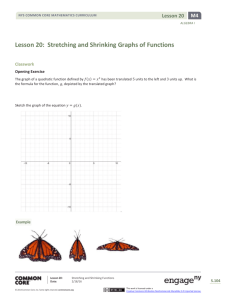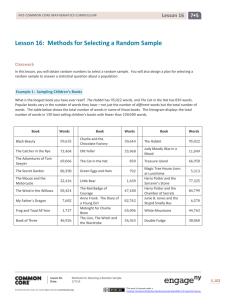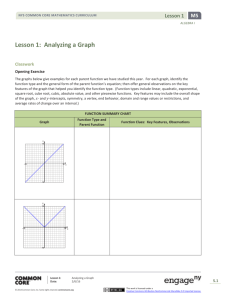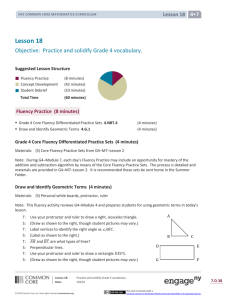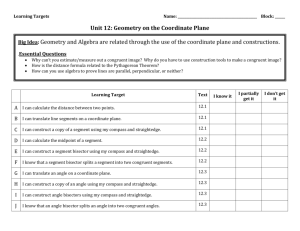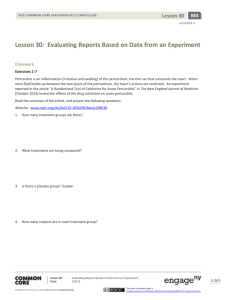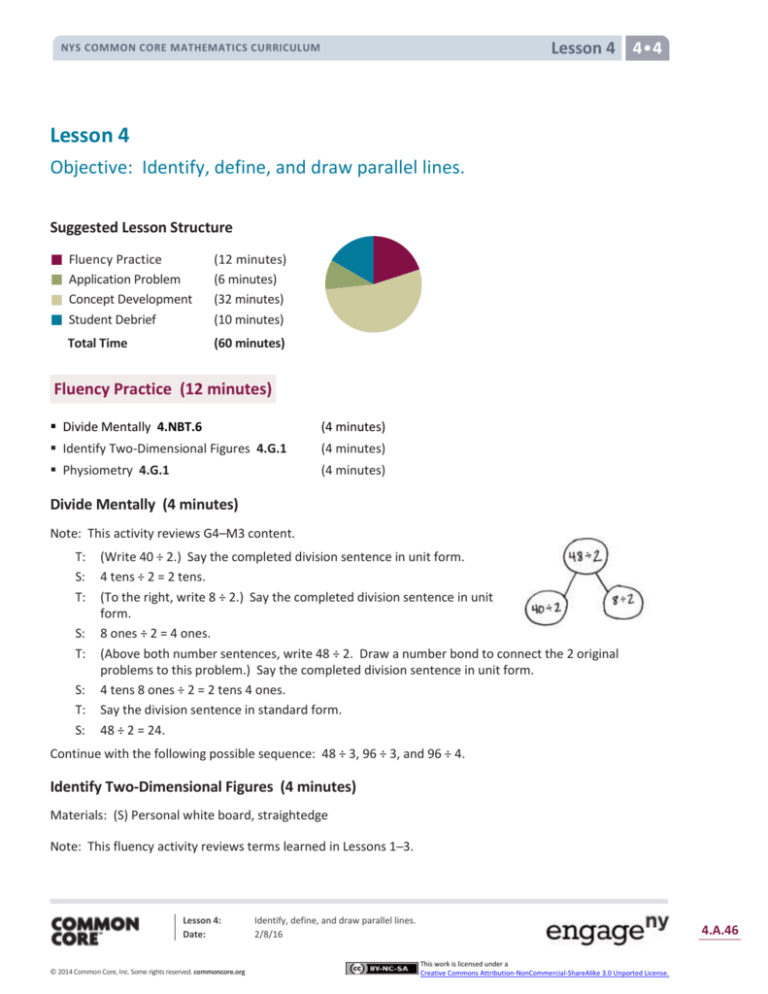
Lesson 4
NYS COMMON CORE MATHEMATICS CURRICULUM
Lesson 4
Objective: Identify, define, and draw parallel lines.
Suggested Lesson Structure
Fluency Practice
Application Problem
Concept Development
Student Debrief
Total Time
(12 minutes)
(6 minutes)
(32 minutes)
(10 minutes)
(60 minutes)
Fluency Practice (12 minutes)
Divide Mentally 4.NBT.6
(4 minutes)
Identify Two-Dimensional Figures 4.G.1
(4 minutes)
Physiometry 4.G.1
(4 minutes)
Divide Mentally (4 minutes)
Note: This activity reviews G4–M3 content.
T:
S:
T:
S:
T:
S:
T:
S:
(Write 40 ÷ 2.) Say the completed division sentence in unit form.
4 tens ÷ 2 = 2 tens.
(To the right, write 8 ÷ 2.) Say the completed division sentence in unit
form.
8 ones ÷ 2 = 4 ones.
(Above both number sentences, write 48 ÷ 2. Draw a number bond to connect the 2 original
problems to this problem.) Say the completed division sentence in unit form.
4 tens 8 ones ÷ 2 = 2 tens 4 ones.
Say the division sentence in standard form.
48 ÷ 2 = 24.
Continue with the following possible sequence: 48 ÷ 3, 96 ÷ 3, and 96 ÷ 4.
Identify Two-Dimensional Figures (4 minutes)
Materials: (S) Personal white board, straightedge
Note: This fluency activity reviews terms learned in Lessons 1─3.
Lesson 4:
Date:
© 2014 Common Core, Inc. Some rights reserved. commoncore.org
Identify, define, and draw parallel lines.
2/8/16
4.A.46
This work is licensed under a
Creative Commons Attribution-NonCommercial-ShareAlike 3.0 Unported License.
Lesson 4
NYS COMMON CORE MATHEMATICS CURRICULUM
T:
S:
T:
S:
T:
S:
T:
S:
⃑⃑⃑⃑⃑ . Trace 𝐴𝐵
⃑⃑⃑⃑⃑ .) Name the figure.
(Project 𝐴𝐵
⃑⃑⃑⃑⃑ .
𝐴𝐵
(Point to point 𝐴.) Say the term.
Point 𝐴.
(Point to point 𝐵.) Say the term.
Point 𝐵.
⃑⃑⃑⃑⃑ on your personal white boards.
Use your straightedge to draw 𝐶𝐷
(Draw a ray with endpoints 𝐶 and 𝐷 on the ray.)
Continue with the following possible sequence: ⃡⃑⃑⃑⃑
𝐸𝐹 , ̅̅̅̅
𝐺𝐻, and acute ∠𝐼𝐾𝐽, obtuse
∠𝐿𝑀𝑁, and right ∠𝑂𝑄𝑃.
T:
S:
T:
S:
What’s the relationship between ̅̅̅̅
𝑂𝑄 and ̅̅̅̅
𝑃𝑄 ?
The line segments are perpendicular.
̅̅̅̅ that is perpendicular to ⃡⃑⃑⃑
Draw 𝑅𝑆
𝑇𝑉.
! that is
(Draw a line segment with endpoints 𝑅 and 𝑆. Draw a line with endpoints 𝑇 and 𝑉
!
̅̅̅̅.)
perpendicular to 𝑅𝑆
!
!
Physiometry (4 minutes)
Note: Kinesthetic memory is strong memory. This fluency activity reviews terms from Lessons 1─3.
T:
S:
T:
S:
T:
S:
T:
S:
T:
S:
T:
S:
T:
S:
T:
S:
Stand up.
(Stand up.)
Model a ray.
(Extend arms straight so that they are parallel with the floor. Clench one hand in a fist, and leave the
other hand open, pointing to a side wall.)
Model a ray pointing in the other direction.
(Open clenched hand, and clench open hand. Point with open hand.)
Model a line.
(Extend arms straight so that they are parallel with the floor. Open both hands, and point at the side
walls.)
Model a point.
(Clench one hand in a fist, and extend arm forward.)
Model a line segment.
(Extend arms straight so that they are parallel with the floor. Clench both hands into fists.)
Model a right angle.
(Stretch one arm up, directly at the ceiling. Stretch another arm directly toward a wall, parallel to
the floor.)
Model a different right angle.
(Stretch the arm pointing toward a wall directly up toward the ceiling. Move the arm pointing
toward the ceiling so that it points directly toward the opposite wall.)
Lesson 4:
Date:
© 2014 Common Core, Inc. Some rights reserved. commoncore.org
Identify, define, and draw parallel lines.
2/8/16
4.A.47
This work is licensed under a
Creative Commons Attribution-NonCommercial-ShareAlike 3.0 Unported License.
Lesson 4
NYS COMMON CORE MATHEMATICS CURRICULUM
T:
S:
T:
S:
Model an acute angle.
(Model an acute angle with arms.)
Model an obtuse angle.
(Model an obtuse angle with arms.)
Next, move between figures with the following possible sequence: right angle, point, line, obtuse angle, line
segment, acute angle, and right angle.
T:
S:
T:
S:
T:
S:
T:
S:
(Stretch one arm up, pointing directly at the ceiling. Stretch another arm directly pointing toward a
wall, parallel to the floor.) Which type of angle do you think I’m modeling?
Right angle.
What is the relationship of the lines formed by right angles?
Perpendicular lines.
(Point at a wall to the side of the room.) Point at the walls that run perpendicular to the wall I’m
pointing to.
(Point at the front and back walls.)
(Point at the back wall.)
(Point at the side walls.)
Continue pointing to the other side wall and front wall.
Application Problem (6 minutes)
Observe the letters R, E, A, and L.
a. How many lines are perpendicular? Describe them.
b. How many acute angles are there? Describe them.
c. How many obtuse angles are there? Describe them.
R E A L
NOTES ON
MULTIPLE MEANS
OF ACTION AND
EXPRESSION:
Help learners keep their response to
the Application Problem organized
with a graphic organizer, such as the
table below:
Letter
Note: This Application Problem reviews perpendicular and
intersecting lines from Lesson 3. The problem can be extended
in the Debrief by having students find letters with parallel lines.
Lesson 4:
Date:
© 2014 Common Core, Inc. Some rights reserved. commoncore.org
Number of
Perpendicular
Lines
Number
of Acute
Angles
Number
of
Obtuse
Angles
R
E
A
L
Identify, define, and draw parallel lines.
2/8/16
4.A.48
This work is licensed under a
Creative Commons Attribution-NonCommercial-ShareAlike 3.0 Unported License.
NYS COMMON CORE MATHEMATICS CURRICULUM
Concept Development (32 minutes)
Materials: (T/S) Straightedge, personal white board, square
grid paper, right angle template (created in Lesson 2)
Problem 1: Define and identify parallel lines.
T:
T:
S:
T:
S:
T:
S:
T:
T:
S:
T:
S:
T:
S:
T:
S:
T:
S:
T:
S:
T:
S:
Lesson 4
NOTES ON
MULTIPLE MEANS
OF REPRESENTATION:
Students have learned a significant
amount of new vocabulary and math
symbols in a short amount of time.
Support English language learners and
others by providing tools such as a
word wall or dictionaries (in first and
second languages in addition to
pictures and symbols) that students
can refer to throughout the lesson.
Include bolded words, as well as
familiar words, such as horizontal.
Partners, lay your two straightedges on your desk. The
straightedges cannot touch each other. Work with
your partner to position your two straightedges like
two roads that will never intersect.
Are your straightedges touching?
No!
If a car continued down your straightedge road, would
it ever be on your partner’s straightedge road?
No!
What do you notice?
Our straightedges are lined up perfectly. Our straightedges are
not perpendicular because they don’t make right angles. They
don’t make any angles because they don’t touch!
You’ve discovered parallel lines. Two lines that never touch no
matter how far you extend them are parallel.
Look on your desk. Can you find parallel lines?
The opposite sides of my personal white board, desk, and book
are parallel.
In our classroom, can you find parallel lines?
The repeating ridges in the heater are parallel. The shelves of
the bookcase are parallel.
(Project the letter N. Trace and label with arrowheads parallel
segments.) Are these segments of letter N parallel?
Yes!
(Project segments 𝐴𝐵 and 𝐶𝐷 as pictured to the right.) Are these
segments parallel?
No!
Why not? I don’t see an intersection?
If you made each one longer, they’d run into each other off to the right.
(Project segments 𝐸𝐹 and 𝐺𝐻 as pictured to the right.) Are these segments parallel?
Yes!
(Project segments 𝐼𝐽 and 𝐾𝐿 as pictured to the right.) Are these segments parallel?
No!
Lesson 4:
Date:
© 2014 Common Core, Inc. Some rights reserved. commoncore.org
Identify, define, and draw parallel lines.
2/8/16
4.A.49
This work is licensed under a
Creative Commons Attribution-NonCommercial-ShareAlike 3.0 Unported License.
Lesson 4
NYS COMMON CORE MATHEMATICS CURRICULUM
Problem 2: Identify parallel lines using a right angle template.
T:
T:
S:
T:
T:
S:
Partner 1, position your straightedge flat on your desk anyway
you like—horizontal, vertical, slanted to the right, slanted to
the left. Partner 2, place your straightedge parallel to your
partner’s. Switch roles, and try again.
Use the word parallel in a sentence that describes your
observations.
Parallel lines look like train tracks. Parallel lines are side by
side without touching. Two lines that do not touch each
other and are the same distance from each other at every
point are parallel. Parallel lines are not perpendicular.
(Project parallel segments 𝑊𝑉and 𝑌𝑍.) Are these segments
parallel? They look parallel, but to be precise, we measure
with a right angle template.
1. First, place a straightedge perpendicular across both
segments.
2. Then, slide the right angle template along the straightedge
to check the alignment.
Are these segments parallel?
Yes!
Repeat activity with a set of non-parallel lines following the process
above.
Problem 3: Represent parallel lines with symbols.
T:
On your grid paper, use your straightedge to draw rectangle 𝐴𝐵𝐶𝐷 like mine. (Model drawing
rectangle 𝐴𝐵𝐶𝐷. Write 𝐴𝐵 on the board.)
When modeling, point out ways to confirm the lines are correctly drawn,
without inferring parallelism yet, such as 𝐴𝐵 moves across three columns and
up one row, as well as 𝐷𝐶. 𝐴𝐷 and 𝐵𝐶 move down six rows and across two
columns. Segments can be extended and erased as needed.
T:
S:
T:
S:
T:
S:
T:
Do you see a segment that is parallel to 𝐴𝐵? Use symbols to record
your answer.
(Show 𝐷𝐶.) Segment 𝐷𝐶!
Let’s check with our right angle template. (Model.)
(Check alignment using right angle template.)
(Assist as needed.) Are 𝐴𝐵 and 𝐷𝐶 parallel?
Yes.
(Write 𝐴𝐵 ∥ 𝐶𝐷). 𝐴𝐵 is parallel to 𝐶𝐷.) Use symbols like mine to record another parallel pair in
the rectangle.
Lesson 4:
Date:
© 2014 Common Core, Inc. Some rights reserved. commoncore.org
Identify, define, and draw parallel lines.
2/8/16
4.A.50
This work is licensed under a
Creative Commons Attribution-NonCommercial-ShareAlike 3.0 Unported License.
Lesson 4
NYS COMMON CORE MATHEMATICS CURRICULUM
S:
T:
S:
T:
MP.3
S:
T:
S:
T:
𝐴𝐷 ∥ 𝐵𝐶.
What do you notice about sides of a rectangle and parallel lines?
Opposite sides of the rectangle are parallel.
Is this true for all rectangles? With your partner, draw rectangles of
different sizes and shapes. Use your right angle template to check
for parallel segments.
(Draw and verify.)
Does the length of the opposite sides of a rectangle change the fact
that they are parallel?
No. Opposite sides of all rectangles are parallel.
As you work on the Problem Set, consider if this is true for other
shapes.
Problem 4: Draw parallel lines.
T:
S:
T:
T:
T:
T:
S:
T:
S:
Use your straightedge to draw horizontal line 𝑋𝑌.
(Draw.)
We found that opposite sides of all rectangles are parallel. We also
discovered in Lesson 2 that rectangles also have four right angles
using our right angle template. We can use right angles to help us
draw parallel lines.
(Model a step at a time, checking on student progress.)
1. First, place your right angle template on ⃡⃑⃑⃑⃑
𝑋𝑌.
2. Second, align your straightedge along the template.
3. Next, slide your right angle template down the straightedge.
4. Align the straightedge against the other straight side of your
⃡⃑⃑⃑⃑ .
template, and draw a line parallel to 𝑋𝑌
⃡⃑⃑⃑ .
5. Lastly, label it as 𝑆𝑇
Use the parallel symbol to write a statement about these two lines.
Draw arrowheads on each line to signify these two lines are parallel
to each other.
Partner 1, draw a straight line—horizontal, vertical, slanted to the
right, or slanted to the left. Partner 2, draw a line parallel to your
partner’s. Remember to draw arrowheads on the parallel lines to
signal that they are, in fact, parallel. Switch roles and try again.
(Draw.)
What do you notice?
Parallel lines are the same distance from each other at every point.
It’s tricky to draw a line that is parallel to a slanted line. Turn
the paper so the line is horizontal or vertical, and it’s easier to draw a
parallel line.
Lesson 4:
Date:
© 2014 Common Core, Inc. Some rights reserved. commoncore.org
Identify, define, and draw parallel lines.
2/8/16
4.A.51
This work is licensed under a
Creative Commons Attribution-NonCommercial-ShareAlike 3.0 Unported License.
NYS COMMON CORE MATHEMATICS CURRICULUM
Lesson 4
Problem Set (10 minutes)
Students should do their personal best to complete the
Problem Set within the allotted 10 minutes. For some
classes, it may be appropriate to modify the assignment by
specifying which problems they work on first. Some
problems do not specify a method for solving. Students
should solve these problems using the RDW approach
used for Application Problems.
Student Debrief (10 minutes)
Lesson Objective: Identify, define, and draw parallel lines.
The Student Debrief is intended to invite reflection and
active processing of the total lesson experience.
Invite students to review their solutions for the Problem
Set. They should check work by comparing answers with a
partner before going over answers as a class. Look for
misconceptions or misunderstandings that can be
addressed in the Debrief. Guide students in a
conversation to debrief the Problem Set and process the
lesson.
You may choose to use any combination of the questions
below to lead the discussion.
In Problem 1, how could your right angle template
serve as a guide for identifying parallel lines?
How do you know if two lines are parallel
(Problem 2)?
In Problem 3, the given line segments were not
drawn on gridlines. What challenge did this pose
in drawing lines parallel to the segments? What
patterns did you find in the grids to help you
analyze if your lines were, in fact, parallel?
Which shapes in Problem 4 had parallel lines? Are
opposite sides always parallel?
How do parallel lines differ from perpendicular
lines?
Two segments that don’t intersect must be
parallel. True or false? Explain.
Lesson 4:
Date:
© 2014 Common Core, Inc. Some rights reserved. commoncore.org
Identify, define, and draw parallel lines.
2/8/16
4.A.52
This work is licensed under a
Creative Commons Attribution-NonCommercial-ShareAlike 3.0 Unported License.
NYS COMMON CORE MATHEMATICS CURRICULUM
Lesson 4
Exit Ticket (3 minutes)
After the Student Debrief, instruct students to complete
the Exit Ticket. A review of their work will help you assess
the students’ understanding of the concepts that were
presented in the lesson today and plan more effectively
for future lessons. You may read the questions aloud to
the students.
Lesson 4:
Date:
© 2014 Common Core, Inc. Some rights reserved. commoncore.org
Identify, define, and draw parallel lines.
2/8/16
4.A.53
This work is licensed under a
Creative Commons Attribution-NonCommercial-ShareAlike 3.0 Unported License.
NYS COMMON CORE MATHEMATICS CURRICULUM
Name
Lesson 4 Problem Set 4•4
Date
1. On each object, trace at least one pair of lines that appear to be parallel.
♫
2. How do you know if two lines are parallel?
3. In the square and triangular grids below, use the given segments in each grid to draw a line that is parallel
using a straightedge.
Lesson 4:
Date:
© 2014 Common Core, Inc. Some rights reserved. commoncore.org
Identify, define, and draw parallel lines.
2/8/16
4.A.54
This work is licensed under a
Creative Commons Attribution-NonCommercial-ShareAlike 3.0 Unported License.
Lesson 4 Problem Set 4•4
NYS COMMON CORE MATHEMATICS CURRICULUM
4. Determine which of the following figures have lines that are parallel by using a straightedge and the right
angle template that you created. Circle the letter of the shapes that have at least one pair of parallel
lines. Mark each pair of parallel lines with arrowheads, and then identify the parallel lines with a
statement modeled after the one in 4(a).
a.
b.
A
H
B
I
̅̅̅̅
𝐴𝐵 ∥ ̅̅̅̅
𝐶𝐷
C
D
J
K
F
c.
d.
E
G
A
M
e.
f.
Z
W
L
F
g.
U
h.
T
O
S
P
R
N
Q
Lesson 4:
Date:
© 2014 Common Core, Inc. Some rights reserved. commoncore.org
Y
V
X
W
Identify, define, and draw parallel lines.
2/8/16
4.A.55
This work is licensed under a
Creative Commons Attribution-NonCommercial-ShareAlike 3.0 Unported License.
Lesson 4 Problem Set 4•4
NYS COMMON CORE MATHEMATICS CURRICULUM
5. True or false? A triangle cannot have sides that are parallel. Explain your thinking.
6. Explain why ̅̅̅̅
𝐴𝐵 and ̅̅̅̅
𝐶𝐷 are parallel, but ̅̅̅̅
𝐸𝐹 and ̅̅̅̅
𝐺𝐻 are not.
B
A
C
D
G
H
7. Draw a line using your straightedge. Now, use your right angle template and straightedge to construct a
line parallel to the first line you drew.
Lesson 4:
Date:
© 2014 Common Core, Inc. Some rights reserved. commoncore.org
Identify, define, and draw parallel lines.
2/8/16
4.A.56
This work is licensed under a
Creative Commons Attribution-NonCommercial-ShareAlike 3.0 Unported License.
Lesson 4 Exit Ticket 4•4
NYS COMMON CORE MATHEMATICS CURRICULUM
Name
Date
Look at the following pairs of lines. Identify if they are parallel, perpendicular, or intersecting.
1. ____________________
3. ____________________
Lesson 4:
Date:
© 2014 Common Core, Inc. Some rights reserved. commoncore.org
2. ____________________
4. ____________________
Identify, define, and draw parallel lines.
2/8/16
4.A.57
This work is licensed under a
Creative Commons Attribution-NonCommercial-ShareAlike 3.0 Unported License.
NYS COMMON CORE MATHEMATICS CURRICULUM
Name
Lesson 4 Homework 4•4
Date
1. On each object, trace at least one pair of lines that appear to be parallel.
2. How do you know if two lines are parallel?
3. In the square and triangular grids below, use the given segments in each grid to draw a line that is parallel
using a straightedge.
Lesson 4:
Date:
© 2014 Common Core, Inc. Some rights reserved. commoncore.org
Identify, define, and draw parallel lines.
2/8/16
4.A.58
This work is licensed under a
Creative Commons Attribution-NonCommercial-ShareAlike 3.0 Unported License.
Lesson 4 Homework 4•4
NYS COMMON CORE MATHEMATICS CURRICULUM
4. Determine which of the following figures have lines that are parallel by using a straightedge and the right
angle template that you created. Circle the letter of the shapes that have at least one pair of parallel
lines. Mark each pair of parallel lines with arrows, and then identify the parallel lines with a statement
modeled after the one in 4(a).
a.
b.
A
B
H
I
̅̅̅̅ ∥ 𝐵𝐷
̅̅̅̅
𝐴𝐵
C
D
J
K
D
c.
d.
O
G
X
e.
O
f.
N
P
Y
M
Z
g.
h.
T
U
S
U
P
R
T
Z
X
Y
V
Q
W
Lesson 4:
Date:
© 2014 Common Core, Inc. Some rights reserved. commoncore.org
Identify, define, and draw parallel lines.
2/8/16
4.A.59
This work is licensed under a
Creative Commons Attribution-NonCommercial-ShareAlike 3.0 Unported License.
Lesson 4 Homework 4•4
NYS COMMON CORE MATHEMATICS CURRICULUM
5. True or false? All shapes with a right angle have sides that are parallel. Explain your thinking.
̅̅̅̅ and 𝐶𝐷
̅̅̅̅ are parallel, but ̅̅̅̅
̅̅̅̅ are not.
6. Explain why 𝐴𝐵
𝐸𝐹 and 𝐺𝐻
F
B
A
C
H
E
D
G
7. Draw a line using your straightedge. Now, use your right angle template and straightedge to construct a
line parallel to the first line you drew.
Lesson 4:
Date:
© 2014 Common Core, Inc. Some rights reserved. commoncore.org
Identify, define, and draw parallel lines.
2/8/16
4.A.60
This work is licensed under a
Creative Commons Attribution-NonCommercial-ShareAlike 3.0 Unported License.





